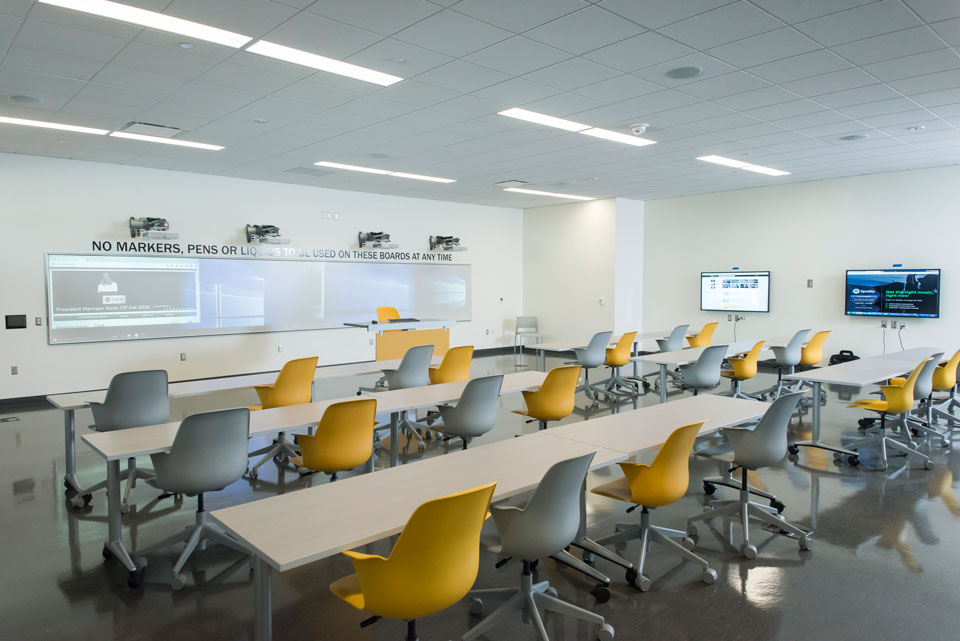Futuristic Classroom Enhances Active Learning for CSUN Students
With the opening of the new Extended University Commons building on campus this fall semester, California State University, Northridge provides students with a new learning experience, introducing the Technology Enhanced Active Learning (TEAL) classroom on the building’s first floor.
The TEAL room offers a variety of new technology to enhance student learning. Unlike other classrooms, faculty who want to use the space must complete an orientation to familiarize themselves with the classroom’s sophisticated environment and work with the Faculty Technology Center and Faculty Development to create a community and share best practices.
“If a faculty member goes into any open lecture room on campus, they typically know what technology is in there and how to use it. This room is a lot more enhanced and not automatically intuitive,” said Leslie Gillman, manager of academic facilities.
Six 55-inch flatscreen TVs span the walls of the classroom, with several plug-ins to enable students to connect their laptops to the screens or charge their electronic devices. The classroom’s tables align with the screens but can also split apart to facilitate group work and active learning assignments.
The classroom’s most cutting-edge feature, however, is the use of we-inspire, a collaborative technology system with digitized whiteboards and pens to enable collaboration with digital material from course content, the internet and real-time work at the board.
“The company provides these specialized [digital] whiteboards,” Gillman said. “You’re not using actual dry erase markers on these, but pens designed to write on the board without leaving marks. Similar to existing smart board technology, they can color, create designs, go out to the internet and collect, capture and show data.”
Faculty members and students can also use specialized pens to draw on paper. The we-inspire software can then project the paper’s content onto the whiteboard. In the classroom, a variety of additional applications will support the overall course workflow and help make presentations as collaborative and engaging as possible.
“There have been studies showing that an active learning classroom improves retention and grades by at least half a grade,” Gillman said. “That’s hopefully one of the benefits we’ll realize from this installation.”
Back in early 2015, a committee was formed to discuss the possible components of a classroom that could push the envelope in terms of its learning environment and technology. The committee consisted of CSUN representatives from IT’s Classroom Technology Support, the Faculty Technology Center, Facilities Planning and Design Construction and the Tseng College of Extended Learning.
The committee decided that this room would provide an excellent opportunity for students to collaborate on the creation of it. Professor Adam Kaplan from the Department of Computer Science and professor Anubhuti Thakur from the Department of Family and Consumer Science engaged students in their classes to work on developing the project’s initial outlines.
“We just gave them a general direction and let them fly with what they thought might work,” Gillman said. “They came up with all kinds of technology and design solutions and presented their findings and recommendations to the committee. back in April 2015”
Considering the students’ ideas, standard protocols and the room’s design, the committee established the final design and technical components of the classroom. After visiting the we-inspire showroom in Los Angeles, the committee agreed on the TEAL’s current configuration. CSU Monterey Bay and Cal State Long Beach also have integrated the we-inspire system in similar settings.
“We went into this knowing that this is an experiment and a pilot,” Gillman said. “It’s not something that would ever be done in all classrooms because it’s just too cost prohibitive. It’s specifically done as a place to explore the active learning classroom model to determine what students and faculty gain from this sort of advanced collaborative space.”
Six faculty members from different departments teach their classes in the futuristic classroom this fall. Five others have expressed interest and participated in the classroom training end of July. Faculty members who are interested in learning more about the TEAL room are encouraged to contact Leslie Gillman at leslie.gillman@csun.edu.





 experience
experience